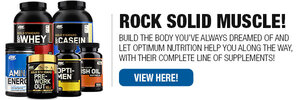01dragonslayer
Ripped
- Jacked Cash
- 487,006
Often, your results depend on how often you’re getting into the gym, what you’re eating outside, and how thoroughly you train. Not rocket science, I know.
But for guys who’ve been in the lifting game for a while, we need to take a closer look to see continuous gains. Looking at the bigger picture (i.e. how things are structured) can be the difference between a half impressive physique and a fully developed monster.
Without getting into the particulars of multi-faceted periodization, here are some check points to get you started on the right foot and build the best program possible.
To gain any initial size as a young or novice lifter, the conventional barbell training movements have to be there in your program, and they must be the hub of your lifts.

Not only are they beneficial for adding muscle and releasing hormones, but they’ll have the largest singular influence on your strength. Regardless of your training phase, they’re not to be avoided.
Long story short, if you’re using plate loaded chest press machines and leg extensions, you’re putting a ceiling on your strength and growth.
Now that also doesn’t mean you have to do the same thing every week but you should include a variation of most of these movements every week.
That could mean a dumbbell overhead press one week, and a barbell push press the next. It could mean front squats one week, and box squats the next. Maybe you throw stationary reverse lunges in one week and forward walking lunges the next.
In the end, what matters the most is that the patterns are implemented within your programming.

On an individual level, we all have muscle imbalances that need to be given attention. The most common one by far is an emphasis on training the postural muscles to be active and counter the front-side dominance exhibited in general society. It often goes beyond just “including a back day” in your program.
The primal movements I listed above are must haves; but, too much of a good thing can eventually cause issues.
For instance, if you have pre-existing shoulder issues due to tight pecs, joint impingement, or poor posture you shouldn’t be overhead pressing or bench pressing every other session.
Instead, you should ensure that you accumulate more volume with rows, pull ups, and other pulling variations. I’m a believer that most of us should train the back twice as often as the chest in to promote good posture and activate the posterior musculature.
The truth is, you’re not going to get that by benching 3 or 4 sets of 10 reps. Even if it means lowering the weight or limiting your rest interval, performing several additional sets per movement is a true key to growth. That’s the reason programs like Gironda’s 8x8 and the classic German Volume Training work so well for growth and development.
Likewise, training for strength depends on just how many sets and reps you perform close to your max effort. Your ramping sets that lead up to the working weight don’t matter, since your nervous system won’t be as involved as it would be during the heaviest sets. One work set of 3 reps at the top of a pyramid is inadequate when compared to 6 or 8 sets of 3.

Doing dumbbell rows after your sets of deadlifts is a cool way to tax both the lower and upper back, but the drawback is, a few sets in, chances are your grip strength will be screaming profanities at you, and your performance will suffer.
Instead, choose movements that involve opposing muscles (front vs back, upper vs lower) during total body workouts, or opposing forces (push vs. pull, row vs fly) on isolation days.
On a similar note, make sure to keep your spinal health and performance in mind when choosing exercise pairs or groups. I’ve found compressive exercises like squats, deadlifts, and overhead presses tend to go very well with de-compressive movements like dips, pull ups, or pulldowns.
Stimulating muscle growth is largely individual, but from my personal experience and clients I’ve worked with, I’ve found that different muscles respond better to certain rep ranges.
We all have fast and slow twitch muscle fibers in our bodies, so we must consider which ones are most responsive to high-volume, endurance based work versus heavy and explosive work in lower rep ranges.
I’ve found that postural and stabilizing musculature, tend to respond well when trained for higher reps. Muscles of the scapulae, quadriceps, and even the upper arm have a high endurance capacity due to their basic function: namely, to maintain repeated contractions over the course of the day.
Sets of 5 or 6 for seated rows, inverted rows, or face pulls will do little to help the muscularity of the upper back. Sets of 4 or 6 leg presses will have little effect on the quadriceps. Attack these muscle groups with high reps, enjoy the pump, and you’ll notice solid growth.
Use these programming pointers, train intuitively, and use good technique. Those 3 tools will make you a force to be reckoned with in the weight room.
But for guys who’ve been in the lifting game for a while, we need to take a closer look to see continuous gains. Looking at the bigger picture (i.e. how things are structured) can be the difference between a half impressive physique and a fully developed monster.
Without getting into the particulars of multi-faceted periodization, here are some check points to get you started on the right foot and build the best program possible.
STEP 1: Stick to the Basics - Primal Movement Patterns
Straight up – you won’t grow if you’re not practicing the big stuff. At this point, however, I’m sure you already knew that.To gain any initial size as a young or novice lifter, the conventional barbell training movements have to be there in your program, and they must be the hub of your lifts.

Not only are they beneficial for adding muscle and releasing hormones, but they’ll have the largest singular influence on your strength. Regardless of your training phase, they’re not to be avoided.
Long story short, if you’re using plate loaded chest press machines and leg extensions, you’re putting a ceiling on your strength and growth.
Now that also doesn’t mean you have to do the same thing every week but you should include a variation of most of these movements every week.
That could mean a dumbbell overhead press one week, and a barbell push press the next. It could mean front squats one week, and box squats the next. Maybe you throw stationary reverse lunges in one week and forward walking lunges the next.
In the end, what matters the most is that the patterns are implemented within your programming.

STEP 2: Create Balance
So now that we’ve laid out a general template for which movements to include, the next question becomes when and how often?On an individual level, we all have muscle imbalances that need to be given attention. The most common one by far is an emphasis on training the postural muscles to be active and counter the front-side dominance exhibited in general society. It often goes beyond just “including a back day” in your program.
The primal movements I listed above are must haves; but, too much of a good thing can eventually cause issues.
For instance, if you have pre-existing shoulder issues due to tight pecs, joint impingement, or poor posture you shouldn’t be overhead pressing or bench pressing every other session.
Instead, you should ensure that you accumulate more volume with rows, pull ups, and other pulling variations. I’m a believer that most of us should train the back twice as often as the chest in to promote good posture and activate the posterior musculature.
A Few Tips
- If you’re doing antagonistic supersets, always choose the pulling exercise before the pushing exercise.
- Stabilizing the shoulder blades by pulling will set you up for a stronger, more stable press movement, and your performance will reflect that.
- If you’re doing straight sets of presses with rest in between, feel free to re-stabilize the scapulae by way of lightly loaded pull movements like banded rows, band pullaparts, or reverse flys.
- Static stretching the antagonistic muscle group (in the case of pull exercises, this would mean a stretch for the chest) immediately before a set of exercise can limit its involvement in that set.
- Use this strategically between sets of rows, pull ups, or reverse flys to maximize the involvement of your postural muscles.
- If you’re programming 2 back workouts per week, try break up movement patterns to specific day.
- On day 1, choose vertical pull movements like pull ups, V grip pulldowns, stiff arm pulldowns, and chins.
- On day 2, choose horizontal pull movements like seated rows, inverted rows, face pulls, and pullovers.
STEP 3: Don’t Forget About Volume!
Whether you’re training for strength or for size, the amount of volume you utilize matters. In the case of training for size, complete muscle exhaustion, blood flow (i.e. the “pump”), and adequate muscular damage are what’s typically suggested.The truth is, you’re not going to get that by benching 3 or 4 sets of 10 reps. Even if it means lowering the weight or limiting your rest interval, performing several additional sets per movement is a true key to growth. That’s the reason programs like Gironda’s 8x8 and the classic German Volume Training work so well for growth and development.
Likewise, training for strength depends on just how many sets and reps you perform close to your max effort. Your ramping sets that lead up to the working weight don’t matter, since your nervous system won’t be as involved as it would be during the heaviest sets. One work set of 3 reps at the top of a pyramid is inadequate when compared to 6 or 8 sets of 3.

STEP 4: Choose the Right Supersets
It’s easy to make the rookie mistake of exhausting one muscle that contributes to another lift in your superset, when that’s not the plan. A perfect example comes on back day (once again!), where pulling exercises are often paired or grouped.Doing dumbbell rows after your sets of deadlifts is a cool way to tax both the lower and upper back, but the drawback is, a few sets in, chances are your grip strength will be screaming profanities at you, and your performance will suffer.
Instead, choose movements that involve opposing muscles (front vs back, upper vs lower) during total body workouts, or opposing forces (push vs. pull, row vs fly) on isolation days.
On a similar note, make sure to keep your spinal health and performance in mind when choosing exercise pairs or groups. I’ve found compressive exercises like squats, deadlifts, and overhead presses tend to go very well with de-compressive movements like dips, pull ups, or pulldowns.
STEP 5: Utilize the Right Rep Ranges
Every muscle group on your body doesn’t deserve the same treatment when it comes to rep ranges, especially where size training is concerned.Stimulating muscle growth is largely individual, but from my personal experience and clients I’ve worked with, I’ve found that different muscles respond better to certain rep ranges.
We all have fast and slow twitch muscle fibers in our bodies, so we must consider which ones are most responsive to high-volume, endurance based work versus heavy and explosive work in lower rep ranges.
I’ve found that postural and stabilizing musculature, tend to respond well when trained for higher reps. Muscles of the scapulae, quadriceps, and even the upper arm have a high endurance capacity due to their basic function: namely, to maintain repeated contractions over the course of the day.
Sets of 5 or 6 for seated rows, inverted rows, or face pulls will do little to help the muscularity of the upper back. Sets of 4 or 6 leg presses will have little effect on the quadriceps. Attack these muscle groups with high reps, enjoy the pump, and you’ll notice solid growth.
Perfecting Program Design
As you can see, everything I wrote wasn’t mind blowing, it’s just using your head to take your program design to the next level. Apply logic and common sense to your training and you’ll bust through plateaus in no time.Use these programming pointers, train intuitively, and use good technique. Those 3 tools will make you a force to be reckoned with in the weight room.

